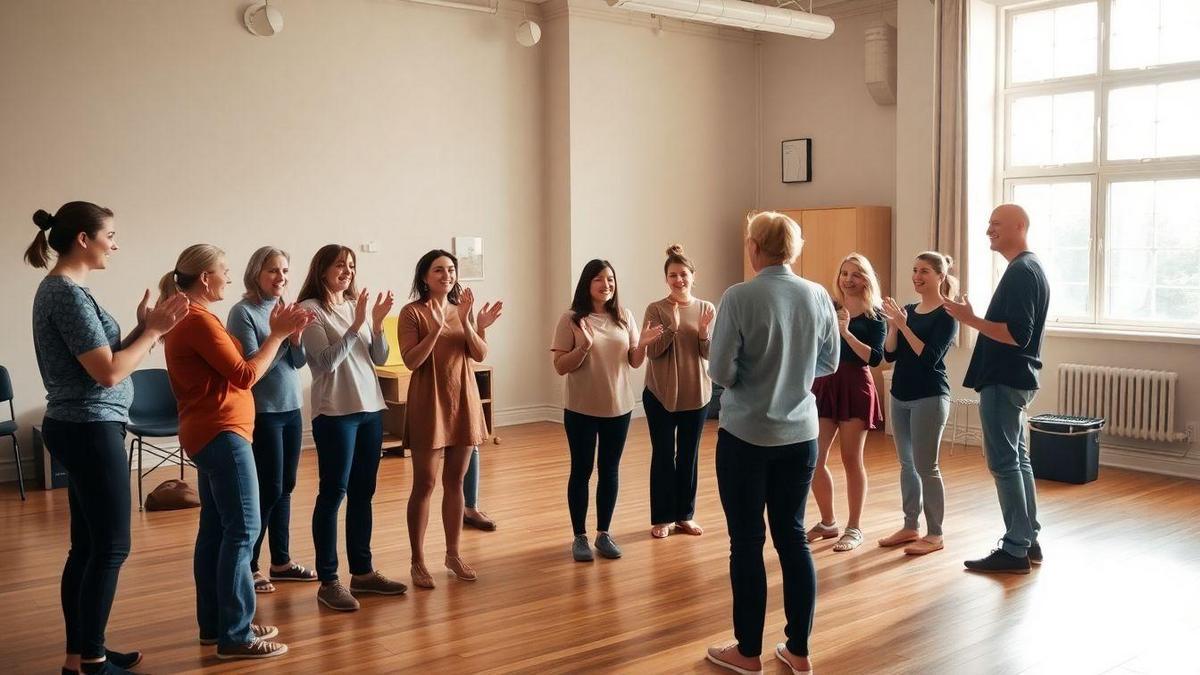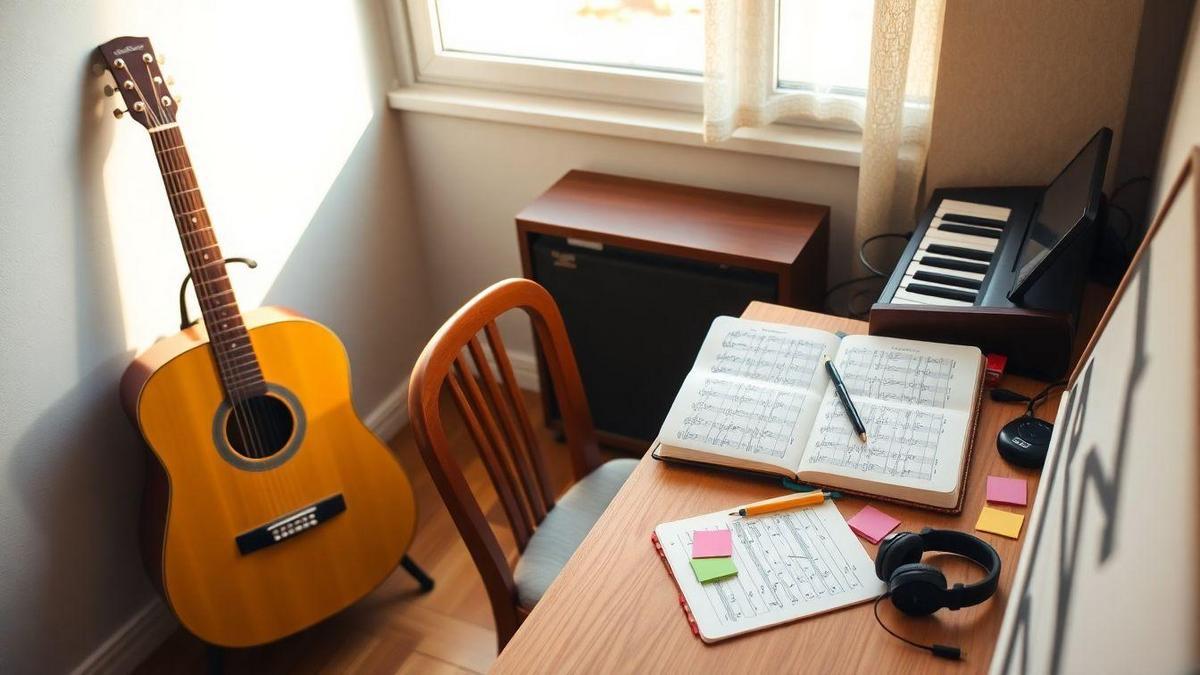Improvisation made simple for absolute beginners
Improvisation made simple for absolute beginners is my warm, practical map to build confidence and have fun while learning to play and perform. I know it feels scary at first, so I start with small, safe steps that help you feel brave. This guide offers quick warm-ups for ears, body, and voice; simple core basics and easy rules that free creativity; musical tools like motifs, scales, and a steady pulse; a one-page cheat sheet and practice roadmap; fun games to build timing and trust; and gentle acting tips, breathing tricks, and a pre-show checklist so you can step out and play with more joy. If you’re still deciding what to start on, my tips on choosing your first instrument without regrets can help you pick something that fits your life.
Key takeaways
- Listen before you play; let the music guide you.
- Start simple, keep a steady pulse, and say “yes” to ideas.
- Practice short patterns and motifs to build confidence.
- Use small rules and repeatable drills to reduce fear.
- Trust your ear and keep trying.

How I turned fear into fun
Improvisation felt like a cliff at first. I learned to step back, take small hops, and focus on listening, playing, and smiling. Treat mistakes as clues, not failures — a mindset explored in how to turn mistakes into learning opportunities. Start with experiments—low stakes and immediate feedback make progress fast. If nerves are what stop you, check strategies for overcoming the fear of starting music.
Why this works:
- Low stakes: first tries are experiments.
- Immediate feedback: hear what works and adjust.
- Playful mindset: curiosity replaces judgment.
- Personal voice: trust your taste, not someone else’s rules.
I still remember my first jam: hands shaking, I played one simple phrase. A nod from someone in the room felt like a lighthouse and pulled me forward.
Small, safe steps to feel brave
Build courage like a house—one brick at a time.
Try:
- Pick one scale or three notes and play slowly (see scales explained in plain English).
- Loop a backing track or drum beat for two minutes and use a click to keep steady (how to use a metronome without losing patience).
- Call it a practice round, not a performance—build a simple habit with a daily practice routine.
- Record a short take and listen kindly.
- Share it with a friend or teacher for gentle feedback.
Simple rules:
- Repeat an idea three times before changing it.
- Pause when overwhelmed—silence is a tool.
- Celebrate tiny wins, like an honest phrase.
These low-pressure steps stack into real confidence.
Quick confidence warm-up (5 minutes)
- Hum or sing a simple melody (1 min) — listen and relax.
- Play one-note rhythm with a metronome (2 mins) — steady timing.
- Improvise with three notes over a beat (2 mins) — play without judgment.
Extra tips: breathe between phrases, keep volume low at first, and laugh if something feels odd. Rituals that help you enter this relaxed state are covered in rituals that help you enter practice mode.

Core basics for absolute beginners
Improvisation is a conversation, not a test. Focus on a few clear ideas to open play.
Essentials:
- Listen first—match the groove.
- Start small—one or two notes can say a lot.
- Repeat and vary—repetition builds confidence.
- Use one scale—stay inside it (see scales explained).
- Phrase like speech—think sentences, then pause.
- Breathe and relax—tension kills creativity.
A simple loop—ask a question, answer it—makes improv feel friendly.
Rules and boundaries that free creativity
Boundaries act like guardrails. For an accessible primer, read an introductory overview of musical improvisation.
Try these constraints:
- Choose a key and stick to it for 5 minutes.
- Limit to three notes for one minute, then add one.
- Keep a steady pulse—treat the beat like a heartbeat.
- Use silence; rests are part of the sentence.
- Play dynamics: soft → loud → soft.
- Say yes to what happens—don’t fight mistakes (see turning mistakes into learning opportunities).
- Stop after a phrase and reflect.
I once told a nervous student to use only three notes; five minutes later they sounded like they’d been playing forever. Avoid common traps by learning about seven beginner mistakes that slow progress.
Simple musical and rhythmic foundations
Foundations are tiny building blocks you can stack on.
Focus on:
- Scales: start with major or pentatonic (5-note) scales (see scales explained).
- Intervals: practice small jumps (steps, skips).
- Rhythm: clap simple patterns and apply them to notes (and try metronome habits from how to use a metronome).
- Motifs: create 2–4 note motifs and repeat with small changes.
- Call and response: play a line, then answer it.
- Timing: count in 4s and phrase in 4- or 8-bar chunks.
Practice drills:
- Play the root on beats 1 and 3 for a minute.
- Improvise with pentatonic for two minutes.
- Repeat a 3-note motif and alter one note each cycle.
A helpful primer on harmonic choices is available in a beginner’s guide to harmony made simple.
One-page cheat sheet
- Key: pick C, G, or D.
- Scale: major or pentatonic.
- Range: stay within one octave.
- Notes: start with 3 notes for 60 seconds.
- Rhythm: 4/4 pulse, count 1-2-3-4.
- Form: think in 4-bar phrases.
- Dynamics: soft → loud → soft.
- Silence: rest every 2–4 bars.
- Mindset: say yes, embrace mistakes.
- Practice: 10 minutes daily beats 1 hour once a week.
Carry this on a small card or phone for quick resets. If you want to read chords or map what you played, see how to read chords and sheet music.

Practice: step-by-step and tiny routines
Break big goals into tiny moves you can do in one breath.
How to practice in tiny steps:
- Pick a small goal (2–4 notes, a rhythm, or a mood).
- Play slowly and feel the pulse.
- Change one thing only (note, rhythm, or timing).
- Repeat until natural, then add a new small goal.
- Tip: use a loop or drone as a safe bed.
- Tip: limit choices to boost creativity.
- Record one take and pick one tiny fix for next time.
For structure, follow a simple daily plan like how to create a simple practice routine or consider the benefits of focused, short sessions in the power of just twenty minutes daily.
Weekly plan for steady progress
- Monday: Tone & feel — long tones, ear matching.
- Tuesday: Small motifs — two-note patterns, variations.
- Wednesday: Rhythm play — clap and apply rhythms.
- Thursday: Call & response — play and answer.
- Friday: Scale comfort — scale fragments and lines.
- Saturday: Free jam — 20–30 minutes with a backing track.
- Sunday: Review — repeat one improvement, set a tiny next goal.
Adjust time by mood and keep a one-line log for growth. Make practice enjoyable with ideas from making practice fun instead of a chore.
My 10-minute practice plan
- Minute 1: breathe and set a tiny goal.
- Minutes 2–3: warm up slowly.
- Minutes 4–6: make three short phrases using the goal.
- Minute 7: change one thing (speed, rhythm, accent).
- Minute 8: free response to the change.
- Minute 9: record or note one line you liked.
- Minute 10: choose one tiny next step.
This short-form focus echoes the benefits of consistent, compact practice in the power of just twenty minutes daily.

Warm-ups that make improvisation reachable
Improvisation made simple for absolute beginners becomes real with small daily habits: listen, move, play, then improvise. For structured exercises, see a simple improv practice and warm-ups guide.
Listening and ear warm-ups:
- Daily five-minute listen: pick a short phrase, play twice, hum it back.
- Echo game: play a lick, repeat it, add one note or a rhythm change.
- Interval naming: call steps, skips, or wide leaps.
- Sing before you play: hum a melody, then find it on your instrument.
- Short transcription: sing and play a 4-bar phrase.
Body and voice warm-ups:
- Posture check: shake shoulders, lift your chest slightly.
- Breath box: three slow belly breaths; exhale with a gentle hiss.
- Neck and wrist loosening: tilt and rotate to free tension.
- Vocal slides: soft sirens on oo or ah.
- Rhythm stomp: tap a steady pulse, add claps on 2 and 4.
Quick warm-up loop (4–6 minutes):
- Listen to a 30–60 sec phrase and hum it back.
- Three deep breaths, shoulder rolls, wrist circles.
- Sing a 2-bar melody and then play it.
- Play one comfortable scale slowly, change one note each repeat (see scales explained).
- Do 4 call-and-response improv rounds.
Listening and music-making also link to wellbeing—see music as therapy: how playing clears the mind.

Fun exercises and games to spark ideas
I built short drills so improvisation made simple for absolute beginners becomes doable fast.
Simple exercises:
- Call-and-response: play a phrase, then answer.
- One-note groove: rhythm with one pitch, then add a new pitch.
- Motif expansion: repeat a 2-bar motif, change one thing each time.
- Question only: use rising phrases that sound like questions.
- Rhythm clap-back: tap a pattern, have a partner copy and invert.
- Silent singing: hum or mouth a melody to reduce fear.
Improv games for timing and trust:
- Mirror: copy simple moves and switch roles.
- Yes-and story: trade 4-bar lines, accept and add.
- Pass the phrase: each player adds a bar in turn.
- Rhythm circle: layer rhythms; laugh if it clashes.
- Emotion flash: improvise one bar in a called mood.
- Dynamics push-pull: trade soft and loud replies.
Short game (5–10 mins): Start with a 2-bar phrase; partner repeats, then changes one small thing; copy the change; repeat for five rounds and swap leaders. For playful ways to keep practice fresh, see making practice fun instead of a chore and ways to break creative blocks in music.

Easy techniques for melody and rhythm
Improvisation made simple for absolute beginners: pick one scale, one rhythm, and tell a short story.
- Pick a scale (pentatonic is forgiving).
- Limit notes to 3–5 initially.
- Use a short, steady rhythm.
- Sing before you play to keep ideas human.
- If a phrase works, repeat with a small change.
How motifs and scales help:
- Motifs: repeatable 2–4 note ideas you return to.
- Scales: a pool of fitting notes—pentatonic or major keeps choices small (see scales explained).
- Combine motif scale: anchor with the motif, then move notes around it.
Starter motif trick:
- Choose pentatonic, pick three notes (e.g., root–3rd–5th).
- Play them short, short, long; repeat twice.
- On the third pass, change one note or rhythm. Return to the original phrase.
Keeping a steady pulse:
- Tap your foot or use a metronome (how to use a metronome).
- Count 1 2 3 4 out loud.
- Play on the beat first, add syncopation later.
- Use rests; silence often says more than notes.
To make melodies that feel immediate, try writing your first melody without overthinking and adding emotion to every note.
Composition through improvisation
Improvisation and composition are two hands shaping the same clay: one experiments, the other builds form. The British Library provides helpful reference material—see the British Library guide to music resources for recording and preserving musical ideas.
Turn improv into songs:
- Record short ideas quickly. Capture before they disappear.
- Pick a small part you like and define it as a motif.
- Loop the motif while testing chords and singing over it.
- Arrange sections (A–B–A) and shape a sketch.
Use improv to find form:
- Play freely for two minutes, then mark timestamps of parts you like.
- Repeated gestures often signal verse; louder or higher moments suggest chorus; contrasts point to bridges.
Simple composing habit (1 minute):
- Record 60 seconds of improv, pick the best 8 seconds, loop it, test harmony, hum over it, arrange A–B–A. For harmony help and to keep things simple, see a beginner’s guide to harmony and whether music theory is really that scary.

Acting improv and stage skills that help music
A few stage skills lift your music fast—presence, space, and breath.
Yes-and listening:
- Echo your partner’s line, then add one detail.
- Musically: hum a harmony that supports rather than shuts down.
- Match emotional tone: support soft/sad with subtle choices.
Presence, space, breath:
- Presence: drop distractions, look at your partner.
- Space: leave room—don’t fill every second.
- Breath: breathe before singing; it steadies pitch and nerves.
Try theatre exercises to build stage presence to develop listening and the “yes-and” stance.
Quick acting drill (5 minutes):
- A makes a short statement (5 words or less).
- B replies Yes, and… and adds one detail.
- Repeat three rounds, swap roles, then add music: A sings a short phrase, B hums a harmony and adds one word.
If you ever wonder what would have helped you sooner on stage, see what I wish I had known.

Calming nerves and pre-show steps
Breath, mindset, and tiny rules help you start. For evidence-based techniques to steady nerves, see practical tips to manage performance nerves.
Breathing and mindset:
- Use a 4–2–6 breath (inhale 4, hold 2, exhale 6).
- Reframe nerves as energy. Talk to yourself kindly: You can try.
- Start with one small rule (one note for a minute, or three chords to sing over).
Practical pre-show steps:
- Warm body and voice for 5–10 minutes.
- Run a short improv drill.
- Check gear and posture.
- Two focused breaths and a pep phrase.
- Step on stage with a tiny goal (one phrase, one groove).
Pre-show checklist:
- Breath: two rounds of 4–2–6.
- Warm-up: 5 minutes of tones or scales.
- Tiny goal: one phrase or note.
- Gear: cables, tuner, backup pick/battery.
- Mind anchor: short phrase (e.g., Play curious).
- Ear check: listen to room or track for 30 seconds.
- Movement: shake shoulders, loosen jaw.
If worries persist, revisit overcoming the fear of starting music and simple pre-show rituals.

Conclusion
Improvisation made simple for absolute beginners is about tiny, repeatable acts: listen first, warm up ears and body, breathe, set a tiny goal, and play. Use simple tools—a cheat sheet, short practice roadmap, quick warm-ups, motifs, a steady pulse, and playful games—to turn fear into fun and build confidence. Practice ten focused minutes a day, record, listen, and shape what works. On stage, anchor with breath, presence, and the Yes, and stance to support others and keep music kind.
Start with curiosity, not perfection. Try one small rule, repeat a motif, celebrate tiny wins. If you want more gentle maps like this one, explore practical ideas on making practice fun and other beginner-friendly guides.

2 comentários em “Improvisation made simple for absolute beginners”